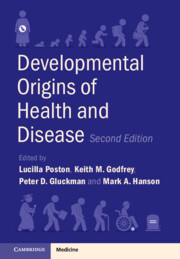Book contents
- Developmental Origins of Health and Disease
- Developmental Origins of Health and Disease
- Copyright page
- Contents
- Contributors
- Preface
- Section I Overview
- Section II Exposures Driving Long-Term DOHaD Effects
- Section III Outcomes
- Section IV Mechanisms
- Chapter 14 Visualizing Structural Underpinnings of DOHaD
- Chapter 15 Molecular and Epigenetic Mechanisms of DOHaD
- Chapter 16 The Role of the Placenta in DOHaD
- Section V Interventions
- Section VI Public Health and Policy Implications of Interventions
- Index
- References
Chapter 15 - Molecular and Epigenetic Mechanisms of DOHaD
from Section IV - Mechanisms
Published online by Cambridge University Press: 01 December 2022
- Developmental Origins of Health and Disease
- Developmental Origins of Health and Disease
- Copyright page
- Contents
- Contributors
- Preface
- Section I Overview
- Section II Exposures Driving Long-Term DOHaD Effects
- Section III Outcomes
- Section IV Mechanisms
- Chapter 14 Visualizing Structural Underpinnings of DOHaD
- Chapter 15 Molecular and Epigenetic Mechanisms of DOHaD
- Chapter 16 The Role of the Placenta in DOHaD
- Section V Interventions
- Section VI Public Health and Policy Implications of Interventions
- Index
- References
Summary
The molecular processes underpinning the relationship between early life exposures and subsequent effects on growth, development and risk of disease remain largely uncharacterized. Despite this, growing evidence implicates epigenetic variation as a key player in this process. Epigenetic variation is complex, involving an interplay between various molecular systems. It is tissue and cell type-specific, dynamic over time, and influenced by both genetic variation and many environmental exposures. Studied for decades in the context of genomic imprinting, X chromosome inactivation, centromere function and neoplasia, recent evidence has not only linked specific epigenetic variation to health phenotypes, but also indicated that epigenetic variation plays a causal role in some cases, beyond just cancers. While this area of research holds much promise, many findings have yet to be replicated, and there are several important analytical considerations that need to be addressed when planning epigenetic studies in order to better elucidate the molecular mechanisms underpinning DOHaD phenomena.
- Type
- Chapter
- Information
- Developmental Origins of Health and Disease , pp. 146 - 165Publisher: Cambridge University PressPrint publication year: 2022

